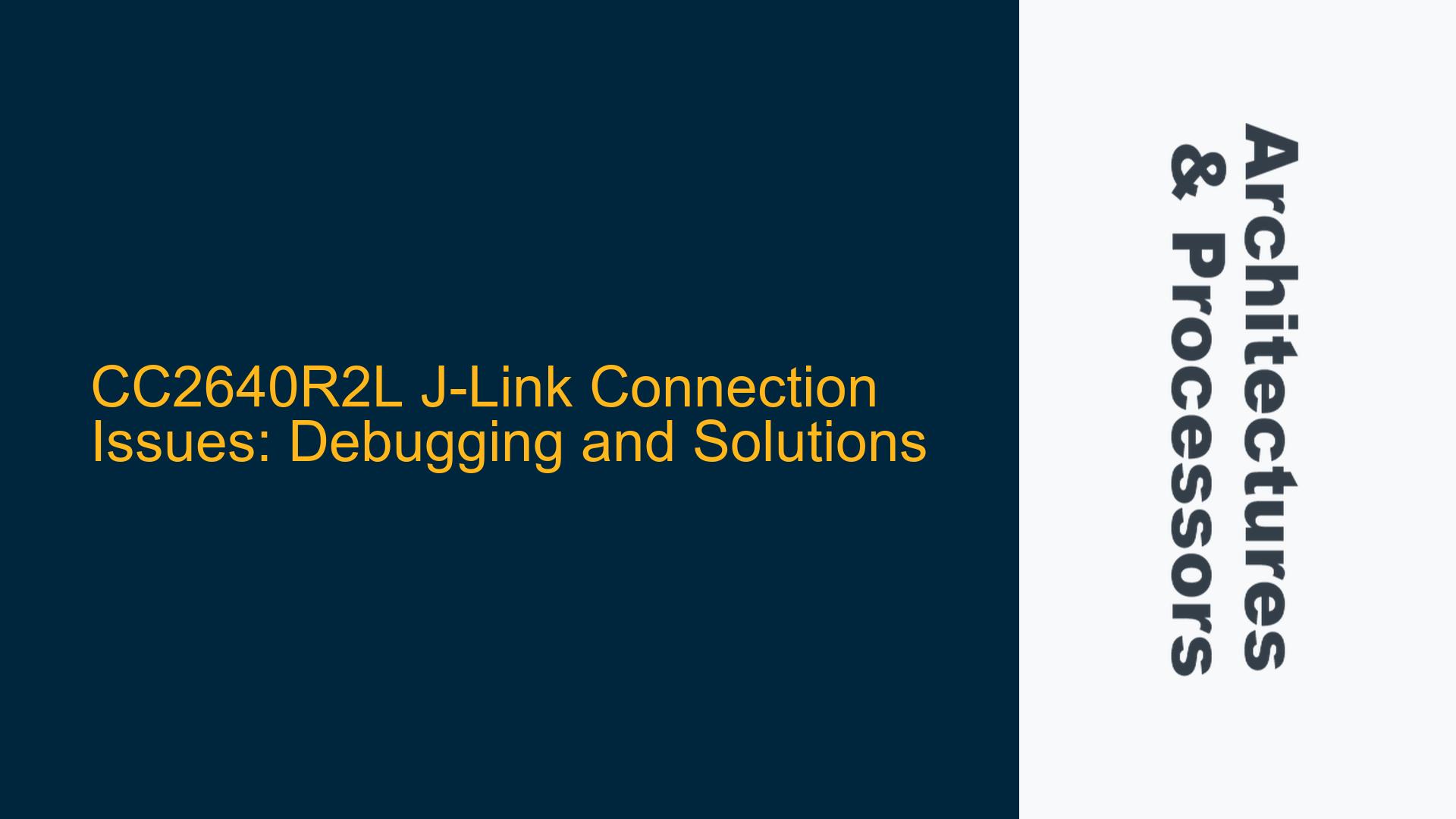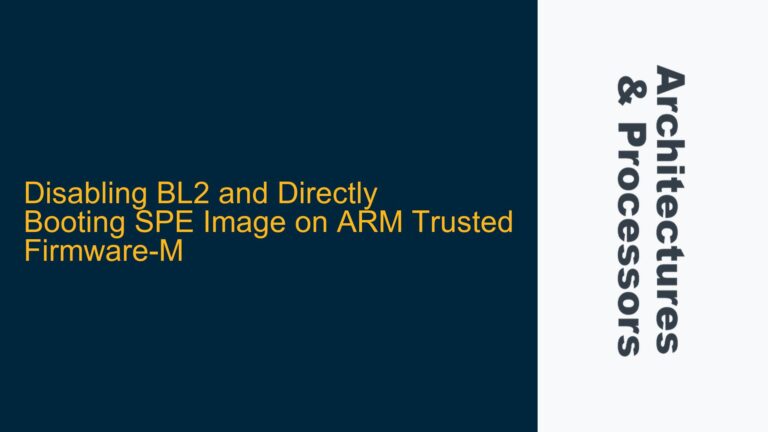ARM Cortex-M3 Debug Interface Connectivity Problems
The CC2640R2L microcontroller, based on the ARM Cortex-M3 architecture, is a popular choice for low-power wireless applications. However, one of the recurring issues faced by developers is the inability to establish a stable connection with the J-Link debugger. This problem can manifest in various ways, including failure to detect the device, intermittent connectivity, or complete communication breakdown during debugging sessions. The debug interface is critical for firmware development, testing, and troubleshooting, making this issue a significant bottleneck in the development workflow.
The ARM Cortex-M3 core in the CC2640R2L relies on the Serial Wire Debug (SWD) protocol for communication with external debuggers like J-Link. SWD is a two-wire interface (SWDIO and SWCLK) that provides a compact and efficient alternative to the traditional JTAG interface. However, the simplicity of SWD also makes it susceptible to connectivity issues caused by hardware design flaws, signal integrity problems, or incorrect software configurations.
When the J-Link fails to connect to the CC2640R2L, the root cause often lies in one or more of the following areas: improper pin connections, insufficient power supply stability, signal integrity degradation, or incorrect debugger settings. Additionally, the CC2640R2L’s internal debug circuitry and its interaction with the external debugger can introduce subtle issues that are not immediately apparent.
Understanding the intricacies of the SWD protocol and the CC2640R2L’s debug architecture is essential for diagnosing and resolving these connectivity problems. The following sections will delve into the possible causes and provide a comprehensive troubleshooting guide to address the issue effectively.
Improper Pin Connections and Signal Integrity Degradation
One of the most common causes of J-Link connectivity issues with the CC2640R2L is improper pin connections. The SWD interface requires precise connections between the debugger and the target device, and any deviation from the recommended configuration can lead to communication failures. The CC2640R2L’s SWD interface consists of two primary signals: SWDIO (Serial Wire Data Input/Output) and SWCLK (Serial Wire Clock). These signals must be correctly routed and connected to the corresponding pins on the J-Link debugger.
In addition to the SWD signals, the CC2640R2L also requires a ground connection and, optionally, a reset signal (nRESET) for reliable debugging. The nRESET signal is used to reset the target device before establishing a debug connection, ensuring that the microcontroller is in a known state. If the nRESET signal is not connected or is improperly routed, the debugger may fail to initialize the target device correctly.
Signal integrity is another critical factor that can affect the stability of the SWD connection. High-speed signals like SWCLK are susceptible to noise, reflections, and crosstalk, which can degrade the signal quality and cause communication errors. Poor PCB layout, long trace lengths, and inadequate decoupling capacitors can all contribute to signal integrity issues. Additionally, the use of improper pull-up or pull-down resistors on the SWD signals can lead to incorrect signal levels, further exacerbating the problem.
To diagnose pin connection and signal integrity issues, it is essential to verify the physical connections between the J-Link debugger and the CC2640R2L. This includes checking for continuity between the debugger and the target device, ensuring that the correct pins are connected, and verifying that there are no short circuits or open connections. Additionally, inspecting the PCB layout for potential signal integrity issues, such as long trace lengths or insufficient decoupling, can help identify and resolve connectivity problems.
Power Supply Stability and Debugger Configuration
Another potential cause of J-Link connectivity issues with the CC2640R2L is instability in the power supply. The CC2640R2L is a low-power device, and its operation is highly sensitive to fluctuations in the supply voltage. If the power supply is unstable or insufficient, the microcontroller may not function correctly, leading to debug connection failures. This is particularly true during the initial power-up sequence, where the CC2640R2L requires a stable voltage to initialize its internal circuits and enter the debug mode.
The power supply stability can be affected by various factors, including inadequate decoupling capacitors, poor PCB layout, or insufficient current capacity from the power source. Additionally, the presence of noise or ripple on the power supply lines can interfere with the CC2640R2L’s operation, causing intermittent connectivity issues or complete communication breakdowns.
Debugger configuration is another critical aspect that can impact the stability of the J-Link connection. The J-Link debugger must be configured correctly to communicate with the CC2640R2L, including setting the appropriate clock speed, voltage levels, and communication protocol. Incorrect settings can lead to communication errors, making it difficult to establish a stable connection with the target device.
To address power supply stability issues, it is essential to verify that the CC2640R2L is receiving a stable and sufficient voltage. This can be done by measuring the voltage at the microcontroller’s power pins using an oscilloscope or multimeter. Additionally, inspecting the PCB layout for proper decoupling and ensuring that the power supply can deliver the required current can help resolve power-related issues.
For debugger configuration, it is important to ensure that the J-Link debugger is set up correctly for the CC2640R2L. This includes selecting the appropriate target device in the debugger software, setting the correct clock speed, and verifying that the voltage levels match the target device’s requirements. Additionally, updating the J-Link firmware and software to the latest version can help resolve compatibility issues and improve the stability of the debug connection.
Implementing Robust Debugging Practices and Hardware Fixes
To ensure a stable and reliable J-Link connection with the CC2640R2L, it is essential to implement robust debugging practices and address any hardware issues that may be affecting the connection. This includes verifying the physical connections, optimizing the PCB layout for signal integrity, and ensuring a stable power supply. Additionally, configuring the J-Link debugger correctly and keeping the firmware and software up to date can help prevent connectivity issues.
One of the first steps in troubleshooting J-Link connectivity issues is to verify the physical connections between the debugger and the target device. This includes checking for continuity between the SWDIO, SWCLK, and nRESET pins, ensuring that the correct pins are connected, and verifying that there are no short circuits or open connections. Additionally, inspecting the PCB layout for potential signal integrity issues, such as long trace lengths or insufficient decoupling, can help identify and resolve connectivity problems.
Optimizing the PCB layout for signal integrity is another critical step in ensuring a stable debug connection. This includes minimizing the length of the SWD traces, using proper termination resistors, and ensuring adequate decoupling capacitors are placed near the CC2640R2L’s power pins. Additionally, avoiding high-speed signal routing near the SWD traces and using ground planes to reduce noise can help improve signal integrity and prevent communication errors.
Ensuring a stable power supply is also essential for reliable debugging. This includes verifying that the CC2640R2L is receiving a stable and sufficient voltage, inspecting the PCB layout for proper decoupling, and ensuring that the power supply can deliver the required current. Additionally, using a low-noise power supply and filtering out any noise or ripple on the power lines can help prevent power-related issues from affecting the debug connection.
Configuring the J-Link debugger correctly is another important step in ensuring a stable connection. This includes selecting the appropriate target device in the debugger software, setting the correct clock speed, and verifying that the voltage levels match the target device’s requirements. Additionally, updating the J-Link firmware and software to the latest version can help resolve compatibility issues and improve the stability of the debug connection.
In some cases, hardware fixes may be necessary to resolve persistent connectivity issues. This can include adding pull-up or pull-down resistors to the SWD signals, using a buffer or level shifter to match voltage levels, or redesigning the PCB layout to improve signal integrity. Additionally, using a dedicated debug connector with proper shielding and grounding can help reduce noise and improve the stability of the debug connection.
By following these troubleshooting steps and implementing robust debugging practices, developers can resolve J-Link connectivity issues with the CC2640R2L and ensure a stable and reliable debug connection. This will enable more efficient firmware development, testing, and troubleshooting, ultimately leading to faster time-to-market and higher-quality products.





